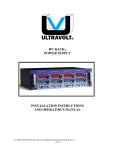Download Philips 55PP9910/17 Rear Projection Television
Transcript
User Manual SET-UP AND BASIC GUIDE HDTV 51PP9910 55PP9910 Thank you for choosing Philips. Need help fast? Read your User Manual first for quick tips that make using your Philips product more enjoyable. If you have read your instructions and still need assistance you may access our online help at www.p4c.philips.com or call 1-800-531-0039 3/24/04 while with your product. 3135 035 22222 PANEL INDEX SUBJECT Panel # 1-2-3 HDTV 1 Getting Connected . . . . . . . . .1 2 Basic Use . . . . . . . . . . . . . . . . .5 3 Basic Installation . . . . . . . . . .10 HDTV Boot Camp Analog versus Digital . . . . . . . .13 Connections . . . . . . . . . . . .14-15 Rear Jack Panel . . . . . . . . . . . . .16 Connecting Your Device AV1 . . . . . . . . . . . . . . . . . . . . .17 AV2 . . . . . . . . . . . . . . . . . . . . .18 SIDE . . . . . . . . . . . . . . . . . . . . .19 AV3 . . . . . . . . . . . . . . . . . . . . .20 AV4 . . . . . . . . . . . . . . . . . . . . .21 AV5 . . . . . . . . . . . . . . . . . . . . .22 SUBJECT Panel # Audio System . . . . . . . . . . . . . . . .23 Troubleshooting . . . . . . . . . . .24-25 HD Compatibility Information . . .26 Glossary . . . . . . . . . . . . . . . . .27-28 Warranty . . . . . . . . . . . . . . . . . . .32 Return your Warranty Registration Card today to ensure you receive all the benefits you’re entitled to. TION Congratulations on your purchase, and welcome to the N ! “family!” To get the most from your PHILIPS product, you rry must return your Warranty Registration Card within 10 u H A I T REG RA DED W YS T EE IS 3 days. So please mail it to us right now! HI N 10 D Once your PHILIPS purchase is registered, you’re eligible to receive all the privileges of owning a PHILIPS product. So complete and return the Warranty Registration Card enclosed with your purchase at once. And take advantage of these important benefits. Warranty Verification Owner Confirmation Model Registration Registering your product within 10 days confirms your right to maximum protection under the terms and conditions of your PHILIPS warranty. Your completed Warranty Registration Card serves as verification of ownership in the event of product theft or loss. Returning your Warranty Registration Card right away guarantees you’ll receive all the information and special offers which you qualify for as the owner of your model. Know these safetysymbols CAUTION RISK OF ELECTRIC SHOCK DO NOT OPEN CAUTION: TO REDUCE THE RISK OF ELECTRIC SHOCK, DO NOT REMOVE COVER (OR BACK). NO USER-SERVICEABLE PARTS INSIDE. REFER SERVICING TO QUALIFIED SERVICE PERSONNEL. t This “bolt of lightning” indicates uninsulated material within your unit may cause an electrical shock. For the safety of everyone in your household, please do not remove product covering. The “exclamation point” calls attention to features for which you should read the enclosed literature closely to prevent operating and maintenance problems. WARNING: TO PREVENT FIRE OR SHOCK HAZARD, DO NOT EXPOSE THIS EQUIPMENT TO RAIN OR MOISTURE. CAUTION: To prevent electric shock, match wide blade of plug to wide slot, and fully insert. ATTENTION: Pour éviter les chocs électriques, introduire la lame la plus large de la fiche dans la borne correspondante de la prise et pousser jusqu’au fond. s Visit our World Wide Web Site at http://www.philips.com IMPORTANT SAFETY INSTRUCTIONS Read before operating equipment 1. 2. 3. 4. 5. 6. 7. 8. 9. 10. 11. 12. 13. 14. 15. 16. Read these instructions. Keep these instructions. Heed all warnings. Follow all instructions. Do not use this apparatus near water. Clean only with a dry cloth. Do not block any of the ventilation openings. Install in accordance with the manufacturers instructions. Do not install near any heat sources such as radiators, heat registers, stoves, or other apparatus (including amplifiers) that produce heat. Do not defeat the safety purpose of the polarized or groundingtype plug. A polarized plug has two blades with one wider than the other. A grounding type plug has two blades and third grounding prong. The wide blade or third prong are provided for your safety.When the provided plug does not fit into your outlet, consult an electrician for replacement of the obsolete outlet. Protect the power cord from being walked on or pinched particularly at plugs, convenience receptacles, and the point where they exit from the apparatus. Only use attachments/accessories specified by the manufacturer. Use only with a cart, stand, tripod, bracket, or table specified by the manufacturer, or sold with the apparatus. When a cart is used, use caution when moving the cart/apparatus combination to avoid injury from tipover. Unplug this apparatus during lightning storms or when unused for long periods of time. Refer all servicing to qualified service personnel. Servicing is required when the apparatus has been damaged in any way, such as power-supply cord or plug is damaged, liquid has been spilled or objects have fallen into apparatus, the apparatus has been exposed to rain or moisture, does not operate normally, or has been dropped. This product may contain lead and mercury. Disposal of these materials may be regulated due to environmental considerations. For disposal or recycling information, please contact your local authorities or the Electronic Industries Alliance: www.eiae.org Damage Requiring Service - The appliance should be serviced by qualified service personnel when: A. The power supply cord or the plug has been damaged; or B. Objects have fallen, or liquid has been spilled into the appliance; or C. The appliance has been exposed to rain; or D. The appliance does not appear to operate normally or exhibits a marked change in performance; or E. The appliance has been dropped, or the enclosure damaged. Note to the CATV system installer: This reminder is provided to call the CATV system installer's attention to Article 820-40 of the NEC that provides guidelines for proper grounding and, in particular, specifies that the cable ground shall be connected to the grounding system of the building, as close to the point of cable entry as practical. 17. 18. 19. 20. 21. 22. Tilt/Stability - All televisions must comply with recommended international global safety standards for tilt and stability properties of its cabinet design. • Do not compromise these design standards by applying excessive pull force to the front, or top, of the cabinet which could ultimately overturn the product. • Also, do not endanger yourself, or children, by placing electronic equipment/toys on the top of the cabinet. Such items could unsuspectingly fall from the top of the set and cause product damage and/or personal injury. Wall or Ceiling Mounting - The appliance should be mounted to a wall or ceiling only as recommended by the manufacturer. Power Lines - An outdoor antenna should be located away from power lines. Outdoor Antenna Grounding - If an outside antenna is connected to the receiver, be sure the antenna system is grounded so as to provide some protection against voltage surges and built up static charges. Section 810 of the National Electric Code, ANSI/NFPA No. 701984, provides information with respect to proper grounding of the mast and supporting structure, grounding of the lead-in wire to an antenna discharge unit, size of grounding connectors, location of antenna-discharge unit, connection to grounding electrodes, and requirements for the grounding electrode. See Figure below. Object and Liquid Entry - Care should be taken so that objects do not fall and liquids are not spilled into the enclosure through openings.comply with recommended international global safety standards for tilt and stability properties of its cabinet design. Battery Usage CAUTION - To prevent battery leakage that may result in bodily injury, property damage, or damage to the unit: • Install all batteries correctly, with + and - aligned as marked on the unit. • Do not mix batteries (old and new or carbon and alkaline, etc.). • Remove batteries when the unit is not used for a long time. Example of Antenna Grounding as per NEC - National Electric Code 1 1-2-3 HDTV - 1 Getting Connected elcome to HDTV. You are about to experience the latest improvement in TV programming since the inception of color from black and white. To begin, you will need to select one of the following connections. Depending on the type of signal source you have. If you are connecting a cable or antenna directly from the wall to your TV, select connection A. If you are connecting a cable box with RF (coaxial) cable output to your TV, select connection B. If you are connecting a cable box or receiver with AV outputs, select connection C. If you are connecting an HDTV cable box, select connection D. W A Cable/Antenna our home’s signal input might come from a single (75 ohm) round cable, a Converter Box, or from an antenna. In either case the connection to the TV is very easy. Y 1 If your Cable TV signal or Antenna signal is a round cable (75 ohm) then you're ready to connect to the TV. If your antenna has flat twin-lead wire (300 ohm), you first need to attach the antenna wires to the screws on a 300 to 75 ohm adapter. 2 Connect the Cable TV cable or Antenna cable (or 300 to 75 ohm adapter) to the 75Ω plug on the TV. 2 B 1-2-3 HDTV - 1 Getting Connected Cable Box with RF Output 1 2 Connect the incoming cable TV signal to the CABLE IN jack on the back of the cable box. 3 Set the Output Channel switch on the back of the cable box to CH 3 or 4 (whichever is correct for your cable box), then tune the TV to the corresponding channel. Once tuned, change channels at the cable box, not the TV. Connect a coaxial cable (not supplied) to the TO TV jack on the back of the cable box and to the CABLE jack on the back of the TV. NOTE: This connection will not supply stereo sound to the TV. The reason is that the RF output on a cable box—labeled “TO TV,” “OUT,” or “OUTPUT,” for example—will not send a stereo signal to the tuner (VHF/UHF) input on a TV. Incoming Cable TV Signal Back of Cable Box (example only) 3 C 1-2-3 HDTV - 1 Getting Connected Analog Cable Box with AV Output 1 Connect the incoming cable TV signal to a signal splitter (not supplied). 2 3 Connect a coaxial cable to a connector on the signal splitter and to the CABLE jack on the TV and connect a coaxial cable to a connector on the signal splitter and to the The signal splitter enables you to avoid having to use the TO TV jack on the back of the cable box. This jack will not supply stereo sound to the TV. CABLE IN jack on the back of the cable box. Connect A/V cables to the VIDEO and AUDIO L and R outputs on the back of the cable box and to the AV1 video (labeled VIDEO) and audio (labeled L and R) jacks on the back of the TV. 4 D 1-2-3 HDTV - 1 Getting Connected Digital Cable Box with AV Output 1 Connect the incoming cable TV signal to a signal splitter (not supplied). 2 3 Connect a coaxial cable to a connector on the signal splitter and to the CABLE jack on the TV and connect a coaxial cable to a connector on the signal splitter and to the The signal splitter enables you to avoid having to use the TO TV jack on the back of the cable box. This jack will not supply stereo sound to the TV. CABLE IN jack on the back of the cable box. Connect the YPbPr (component) VIDEO OUT jacks from the Cable Box to the AV 4 YPbPr (component video) jacks on the rear of the TV. Connect the AUDIO OUT L(eft) and R(ight) jacks from the Cable Box to the AV 4 AUDIO jacks on the rear of the TV. 5 1-2-3 HDTV - 2 Basic Use ow that your set is connected, take a few minutes to familiarize yourself with some basic controls. N TV and Remote TV BUTTONS 1 2 3 4 5 Press the POWER button to turn the TV ON. Note: You can also press any button on the front of the TV to turn the TV ON. Press the VOLUME + button to increase the sound level, or the VOLUME – button to lower the sound level. Pressing both buttons at the same time will display the on-screen menu. Once in the menu, use these buttons to make adjustments or selections. Press the CHANNEL UP 5 or DOWN ∞ button to select TV channels. Press SOURCE SELECT then use the CHANNEL UP and DOWN button to select an AV SOURCE. Press VOLUME + to confirm. Point the remote control toward the remote sensor window on the TV when operating the TV with the remote. REMOTE CONTROL o load the supplied batteries into the remote: T 1 2 3 Remove the battery compartment lid on the back of the remote. Place the batteries (2-AA) in the remote. Be sure the (+) and (-) ends of the batteries line up correctly (inside of case is marked.) Reattach the battery lid. Back of Remote Battery Compartment 2-AA Batteries Battery Lid 6 1-2-3 HDTV - 2 Basic Use REMOTE CONTROL BUTTON DESCRIPTIONS AV Buttons Press to access the AV Source menu. Then use Cursor Buttons to select the different signal sources connected to the TV: Antenna, Cable AV1, AV2, AV3, AV4, AV5, Side. MUTE Button Press to turn the TV sound off. To restore the sound to its previous level, press the button again. PIP buttons: PIP, POS, SWAP, FREEZE Press to operate the Picture-in-Picture (PIP) features. See page 4 of the Advanced Instructions Guide Button Press to open the guide feature of your TV. For Digital programs, the guide provides information about the broadcast. OK Button Press to toggle between locked and unlocked in the AutoLock menu. INFO/EXIT Button Press to display the INFO screen. Also can be used to exit the On Screen Menu. CURSOR Buttons Up/Down: allows you to select the next or previous menu item in the menu. Up/Down also can be used for quick tuning to major channels without going through subchannels.Left/Right: allows you to access the submenus and adjust the settings. Volume + or - Button Press the VOL + button to increase the TV’s sound level. Press the VOL – button to decrease the TV’s sound level. NUMBERED (0-9) Buttons Press the numbered buttons to select TV channels or to enter certain values within the onscreen menu. For single channel entries, press the numbered button for the channel you desire. The TV will pause for a second or two before changing to the chosen channel. A/CH Button (Alternate Channel) Press to toggle between the last viewed channel and the channel presently being viewed. 7 1-2-3 HDTV - 2 Basic Use REMOTE CONTROL BUTTON DESCRIPTIONS POWER Button Press to turn the TV On or Off. Please note that due to the nature of DTV, the set will take longer to fully power-up than you are used to. FORMAT Button Press to select a picture format mode for a video source connected to the ANTENNA/CABLE or AV input. Each press of the button selects a different mode: Native (16:9), 4:3, Panoramic, Zoom. TIMER Button Press to access the TIMER menu. SURF Button Press to select previously entered channels. With the TV’s Surf control, you can place up to 10 favorite channels in memory. Then by pressing the Surf button, you can quickly view the selected channels. MENU Button Press to activate the On Screen Menu. While navigating the menu, press to back up a level. CH(annel) + or - Buttons Press to select channels in ascending or descending order. DSURF Button Press this button to activate DSURF. While in DSURF mode, the TV only tunes to Digital channels and subchannels. Subchannel Direct Access Button Press the button in conjuction with the numbered buttons (0-9) to directly access digital channels (for example 9.1). HELPFUL HINTS • Press CURSOR UP and DOWN to surf through the major channels, bypassing all minor channels and subchannels. 8 1-2-3 HDTV - 2 Basic Use HOW TO USE THE ON-SCREEN MENU menu is simply a list of options. You can adjust or set your TV’s onscreen menu options by pressing buttons on the remote control. The following steps will familiarize you with how to use the remote control with the onscreen menu. A 1 2 Press the MENU button to bring the menu to the screen. Press the CURSORDOWN or UP button to highlight a menu option. Press the CURSOR RING RIGHT to enter the submenu for the option. Within the submenu, press the CURSOR BUTTON DOWN or UP to highlight an option. Based on the submenu you are in, you can press the CURSOR RIGHT button or LEFT to make an adjustment, select a setting, or enter a list or another submenu. To go from a submenu to the previous menu, highlight the option at the top of the screen and press the CURSOR UP BUTTON. You can also press MENU to return to the previous menu. 3 Press INFO/EXIT to exit the menu. 1-2-3 HDTV - 2 Basic Use 9 COMMON INFORMATION AND CHANNEL SCREEN our Philips DTV can display chanChannel nel information in one of two ways. The amount of information displayed in each will depend on the Small Banner Analog whether the channel is digital or analog, the broadcaster, and your preference. You can select a large or small channel banner. Channel Type he banner can only display the Channel and Name program name, time and a brief description if the broadcaster is sending the information. Small Banner Y T Available Subchannels Digital HELPFUL HINTS • The large channel banner displays the same information shown when you press the INFO BUTTON. Channel Type Large Banner Digital Current date and time Channel and Name Signal Type Program name Program time Program information Signal Strength Available Subchannels 10 1-2-3 HDTV - 3 Basic Installation ow that you are familiar with the basic operation of your TV, follow the next steps to correctly install the correct menu language, tuner mode, and Channel N list. LANGUAGE he menu LANGUAGE control enables you to set the TV’s onscreen menu and onscreen displays to be shown in English, French, or Spanish. Follow the steps in this section to set the control. T 1 2 Press the MENU button. The onscreen menu appears. 3 Press the CURSOR DOWN button and then CURSOR RIGHT button to highlight the menu LANGUAGE options list. 4 Press the CURSOR DOWN or UP button to select your menu language. Press the CURSOR DOWN button repeatedly until INSTALL is highlighted. Then press the CURSOR RIGHT button to enter the INSTALL submenu. Immediately, the onscreen displays appear in the language that you choose. 5 Press the INFO/EXIT button to exit the menus. 11 1-2-3 HDTV - 3 Basic Installation TUNER MODE CONTROL et the TUNER MODE control according to the type of signal you have connected to the TV— ANTENNA or CABLE. S 1 Press the MENU button. The onscreen menu appears. Press the CURSOR DOWN button repeatedly until INSTALL is highlighted. 2 Press the CURSOR RIGHT button to enter the INSTALL submenu. Then press the CURSOR DOWN button until TUNER MODE is highlighted. 3 Press the CURSOR RIGHT button to highlight the TUNER MODE options list. 4 Press the CURSOR DOWN or UP button repeatedly until you select the option that matches your signal connection, CABLE or ANTENNA. 5 6 Press the INFO/EXIT button to exit the menu. Proceed to the section on “Auto Program.” 12 1-2-3 HDTV - 3 Basic Installation AUTO PROGRAM he AUTO PROGRAM feature will scan for channels with active broadcast signals and store those channels in the TV’s memory. It will tune up to 69 analog and 69 digital channels for antenna, and up to 135 analog and 135 digital channels for cable. First it will search and store all analog channels, then search and store digital channels. After you run AUTO PROGRAM, you can use the CH(annel) +/– buttons to quickly and easily select stations. T 1 Press the MENU button. The onscreen menu appears. Then press the CURSOR DOWN button repeatedly until INSTALL is highlighted. 2 Press the CURSOR RIGHT button to enter the INSTALL submenu. Then press CURSOR RIGHT button again. Autoprogramming begins immediately. 3 When the programming is done, press the INFO/ EXIT button to exit the menu. HELPFUL HINTS • Due to the nature of Digital Television signals, programming may take more time than you are accustomed to. (Up to 30 minutes) HDTV BOOT CAMP 13 Analog Digital Channels Whether you use a high-tech, multifunction remote control or a dial, analog channels are what we’ve been watching for many years. What you see is what you get. Channels With Digital TV, each channel can have up to 999 subchannels. Broadcasters can use these to send a variety of information. Subchannels are represented in this format:10.2. In this example “10” is the major channel and “2” is the subchannel. You may also see this written as 10-2. Signal Strength If the signal from the broadcaster or cable provider is weak or suffers interference, your picture and sound quality will diminish. You can improve the picture by adjusting the antenna or removing sources of interference. Signal Strength Signal strength for digital signals is only an issue at a critical point. With digital TV you either have a crystal clear picture or none at all. This means that under normal circumstances, you will not have to adjust your antenna. If a signal is so weak that it does not produce a picture you can adjust your antenna to see if it helps. However, you will either have clear picture and sound or none at all. Important: Even if they register as strong signals, your DTV treats scrambled signals as if they are weak signals. No amount of antenna fine tuning will resolve a scrambled signal. Channel Tuning and Autoprogramming Analog channels only carry a small amount of information and are almost instantaneously tuned by a TV. Likewise, it takes only long enough to surf through the channels for the TV to autoprogram analog channels. Channel Tuning and Autoprogramming Digital channels carry a great deal more information. In addition they may have up to 999 subchannels. This means it takes longer for a TV to tune to a digital channel. You may notice a slight delay as you surf digital channels This also effects autoprogramming which may take up to 30 minutes depending on the number of digital channels available. 14 HDTV BOOT CAMP Connections and Jacks This page contains descriptions and illustrations of jacks, cables, and connectors you might use in making connections. The cables and connectors are not supplied with your TV, but you can purchase them at your electronics dealer. Or, you can order them by calling our Customer Care Center at 1-800-531-0039. HDMI Input Jack Cable used: HDMI This jack works with HDMI (High Definition Multimedia Interface) digital signals. Allows encrypted transmissions of uncompressed, high definition digital content. It supports both digital video and digital audio signals. HDMI Jack Cables Used: HDMI Component Video Input Jacks (Red, Blue, Green) Cables used: component video with RCA-type phono plugs Allow you to connect accessory devices such as DVD players. Separating the video into three signals, these inputs provide excellent quality. Be sure to connect the left and right audio cables, because the Y, Pb, Pr jacks receive only the picture signal. Component Video Jacks Cables Used: Component Video with RCA-type Phono Plugs Pr Pb Y Red Blue Green S-Video Input Jacks Cable used: S-Video Provide a higher quality picture than the Video (composite) jacks because the color part of the picture is separated from the black and white portion. Be sure to connect the left and right audio cables, because the S-Video jacks receive only the picture signal. S-VIDEO Jack Cable Used: S-Video G S-VIDEO Video (“CVBS” or “composite”) Input Jacks (Yellow) Video (Composite) Jack Cable Used: Video with Cable used: Video with RCA-type phono plugs Provide better picture performance than the antenna RF RCA-type Phono Plugs input for analog channels. Be sure to connect the audio cables, because the video jacks receive only the picture signal. Yellow 15 HDTV BOOT CAMP Connections and Jacks Tuner (RF) Input Jack Cables used: RF coaxial cable (75Ω) Antenna RF Jack Cable Used: RF Coaxial (75Ω) Allows you to connect an antenna, cable TV, or components having RF outputs to the antenna input on the TV. TUNER Signal Splitter Cables Used: RF Coaxial (75Ω) Signal Splitter Allows you to route an antenna or cable TV signal to two inputs. 300- to 75-ohm Twin-lead Adapter 300- to 75-ohm Twin-lead Adapter Accepts twin-lead wires from an antenna and allows connection to the antenna input on the TV. If your antenna is already equipped with an RF coaxial cable you will not need this adapter. Analog and Digital Audio Jacks (Red and White, Orange) Cables used:Audio with RCA-type phono plugs for analog and Coaxial Digtial SPDIF for digital. Provide sound for the video inputs. If your accessory device has only one output for audio, connect it to the left (color coded white) audio jack on the TV. TUNER Audio Jacks Cables Used: Audio with RCA-type Phono Plugs Audio Jacks Cables Used: Coaxial Digital Audio (SPDIF) COAX R L Red White Orange 16 HDTV BOOT CAMP Connections Antenna Connect an antenna to this jack. The TV can receive Digital and Analog broadcast signals. Cable Connect the Coaxial cable to this jack. The TV can receive Digital and Analog cable signals. AV5 This includes an HDMI jack to connect an HDMI device. You can also use a DVI to HDMI converter along with the left/right audio jacks to connect a DVI device.. Digital Audio Out Connect a digital audio device to this Jack. AV3 This includes component video (Y, Pb, Pr or RGB), HV Sync, and, audio jacks. Use this to connect a DVD player. AV1 This includes an S-Video, Video, and audio jacks. Use this to connect a VCR. Input Signal Compatibility: AV4 This includes component video (Y, Pb, Pr or RGB) and audio jacks. Use this to connect an HD settop box. AV2 This includes an SVideo, Video, and audio jacks. Use this to connect a Personal Video Recorder. AV1 . . . . NTSC (480i) AV2 . . . . NTSC (480i) AV3 . . . . 480i, 480p, 720p, 1080i AV4 . . . . 480i, 480p, 720p, 1080i AV5 . . . . HDMI (DVI with a converter) Antenna/ NTSC, ATSC, QAM Cable . . . (480i, 480p, 720p, 1080i) ANALOG AUDIO OUT Connect an analog audio device to these jacks. 17 CONNECTING YOUR DEVICES AV1 ANALOG se AVI for any device which uses a composite video or S-Video connec- U tion. Optimized for: VCR Other Options: Cable Box, DVD, etc... Refer to the directions-for-use manual for your device for further information on connections. 1 Connect the VIDEO OUT jack or S-Video jack on the rear of the device to the INPUT AV1 VIDEO or S-VIDEO jack on the rear of the TV. 2 Connect the audio output R(ight) and L(eft) jacks on the rear of the device to the AV 1 AUDIO jacks on the rear of the TV. NOTE: If the device is a mono (nonstereo) unit, connect only the left audio cable, which usually has a white connector. You will also need to select MONO in AUDIO menu, see panel 12 in the Advanced Instructions. 3 Press the AV button on the remote control to open the AV Source menu. Then press the CURSOR UP or DOWN button to select the AV1 source for the viewing of materials from your device. Press CURSOR RIGHT button to confirm. 18 CONNECTING YOUR DEVICES AV2 ANALOG se AV2 for any device which uses a composite video or S-Video connec- U tion. Optimized for: Personal Video Recorder Other Options: VCR, DVD, etc.... Refer to the directions-for-use manual for your device for further information on connections. 1 Connect the VIDEO OUT jack or S-Video jack on the rear of the device to the INPUT AV2 VIDEO or S-VIDEO jack on the rear of the TV. 2 Connect the audio output R(ight) and L(eft) jacks on the rear of the device to the AV 2 AUDIO jacks on the rear of the TV. NOTE: If the device is a mono (nonstereo) unit, connect only the left audio cable, which usually has a white connector. You will also need to select MONO in AUDIO menu, see panel 12 in the Advanced Instructions. 3 Press the AV button on the remote control to open the AV Source menu. Then press the CURSOR UP or DOWN button to select the AV2 source for the viewing of materials from your device. Press CURSOR RIGHT button to confirm. 19 CONNECTING YOUR DEVICES Side AV ANALOG se Side AV for any device which uses a composite video or S-Video connec- U tion. Optimized for: Game Console Other Options: VCR, Cable Box, Camcorder, etc... Refer to the directions-for-use manual for your device for further information on connections. 1 Connect the S-VIDEO or VIDEO OUT jack on the rear of the device to the S-VIDEO or VIDEO jack on the side panel of the TV. 2 Connect the audio output R(ight) and L(eft) jacks on the rear of the device to the AUDIO jacks on the side panel of the TV. NOTE: If the device is a mono (nonstereo) unit, connect only the left audio cable, which usually has a white connector. You will also need to select MONO in AUDIO menu, see panel 12 in the Advanced Instructions. 3 Press the AV button on the remote control to open the AV Source menu. Then press the CURSOR UP or DOWN button to select the SIDE source for the viewing of materials from your device. Press CURSOR RIGHT button to confirm. 20 CONNECTING YOUR DEVICES AV3 ANALOG/DIGITAL se AV3 to connect any device which uses component video cables. This input can process standard, enhanced, and high definition signals. Refer to the directions-for-use manual for your device. for further information on connections. Optimized for: Set-top Box Other options: DVD, Progressive scan DVD, etc... U 1 Connect the YPbPr or RGB(component) VIDEO OUT jacks from the device to the AV 3 YPbPr (component video) jacks on the rear of the TV. 2 Connect the AUDIO OUT L(eft) and R(ight) jacks from the device to the AV 3 AUDIO jacks on the rear of the TV. 3 Press the AV button on the remote control to open the AV Source menu. Then press the CURSOR UP or DOWN button to select the AV3 source for the viewing of materials from your device. Press CURSOR RIGHT button to confirm. HELPFUL HINTS • If you are using a RGB device with H,V sync use AV3. It is the only AV with H,V Sync jacks. 21 CONNECTING YOUR DEVICES AV4 ANALOG/DIGITAL se AV4 to connect any device which uses component video cables. This input can process standard, enhanced, and high definition signals. Refer to the directions-for-use manual for your device. for further information on connections. Optimized for: DVD PLAYER Other options: HD Set-Top Box Progressive scan DVD,etc... U 1 Connect the YPbPr (component) VIDEO OUT jacks from the device to the AV 4 YPbPr (component video) jacks on the rear of the TV. 2 Connect the AUDIO OUT L(eft) and R(ight) jacks from the device to the AV 4 AUDIO jacks on the rear of the TV. 3 Press the AV button on the remote control to open the AV Source menu. Then press the CURSOR UP or DOWN button to select the AV4 source for the viewing of materials from your device. Press CURSOR RIGHT button to confirm. 22 CONNECTING YOUR DEVICES AV5 DIGITAL o connect an HDMI device or a DVI device with a converter use AV5. Refer to the directions-for-use manual for your HDMI device for further information on connections. Optimized for: HD Set-Top box Other options: Digital DVD. T 1 Connect the HDMI OUT jack from the device to the AV 5 HDMI jack on the rear of the TV. 2 Press the AV button on the remote control to open the AV Source menu. Then press the CURSOR UP or DOWN button to select the AV5 source for the viewing of materials from your device. Press CURSOR RIGHT button to confirm. HELPFUL HINTS • You can also connect a DVI device by using a DVI to HDMI converter cable and connecting the AV 5 left/right audio jacks. 23 CONNECTING YOUR DEVICES AUDIO SYSTEM ANALOG/DIGITAL ou can use your TV’s AUDIO OUTPUT jacks to connect to an external audio hi-fi system. Follow the simple steps below. Y Digital Audio 1 Connect the DIGITAL AUDIO OUT COAX (or SPDIF) jack on the rear of the TV to the DIGITAL INPUT (coax) jack on the rear of the hi-fi system. Analog Audio 1 Connect the L(eft) and R(ight) ANALOG AUDIO OUT jacks on the rear of the TV to the L(eft) and R(ight) AUX/TV INPUT jacks on the rear of the hi-fi system. 24 TROUBLESHOOTING Check This List of Symptoms and Possible Solutions Before Requesting Service You may be able to solve the problem yourself. Charges for TV installation and adjustment of customer controls are not covered under your warranty. If you need to call a customer service representative, please know the model number and serial number of your product before you call. This information is displayed on the back of the product. Also, please take a moment to identify the problem you are having, and be prepared to explain this to the representative. If you believe the representative will need to help you with operations, please stay near the product. Our representative will be happy to assist you. To reach our Customer Care Center, call 1-800-531-0039. Difficulties and Possible Solutions. The TV remote control does not work • Check that the batteries are installed correctly. • If the batteries are dead, replace them with two “AA” size heavy duty (zinc chloride) or alkaline batteries. • Be no farther than 30 feet from the TV when using the remote control and point the remote toward the remote-sensor window on the TV. • Clean the remote control and the remote-sensor window on the TV. • Check the TV power cord. Unplug the TV, wait 10 seconds, then reinsert the plug into the outlet and push the remote power or TV power/standby button again. • If you have your TV plugged into an AC power strip, ensure that the fuse on the power strip is not blown. • Check to see if the TV is on a wall switch. The TV has no power • Check the TV’s power cord. Unplug the TV, wait 10 seconds, then reinsert the plug into the outlet and push the remote-control power or TV power/standby button again. • Check that the outlet is not on a wall switch. • If you are using an AC power strip, be sure the fuse on the power strip is not blown. You cannot get a picture • Be sure that you have made signal connections correctly and securely. • Check the Tuner Mode control for the correct tuner setting. • Try running the Auto Program feature. • Ensure that you have selected the correct picture signal source using the AV (remote) or Source Select (TV) buttons. • If you are attempting to view a picture from a progressive-scan-capable DVD player to the HD inputs, ensure that you have switched the DVD player to progressive-scan mode. • If you are using an HD receiver, ensure that its output is set correctly (HD or 25 TROUBLESHOOTING, CONTINUED SD) based on the connection to the TV you have made. You cannot tune to a particular channel • Use the number buttons on the remote instead of the CH +/– buttons. • If necessary, select the Tuner Mode and run Auto Program to store channels to the set’s memory. • Make sure DSURF is not active. You see scrolling images • Check to ensure that you have made connections correctly. • If you have connected digital equipment to the HD inputs, check/change the colorspace setting on the equipment or TV. • If the picture has red or blue fringes, you may need to adjust the convergence. You are not able to get sound • Check the Volume buttons on the remote control or on the TV. • Check the Mute button on the remote. • Check the Audio Out and Speaker controls. • If you have connected auxiliary sound equipment, check to ensure that you have made the audio connections correctly. TV displays wrong channel or no channels above 13 • Try selecting the channel again. • Add the desired channel numbers into the TV using the Channel Edit control. • Check to ensure that the Tuner Mode is properly set and run Auto Program. If nothing above solves your problem, unplug the TV for 60 seconds to completely reset it. 26 C OMPATIBILITY INFORMATION FOR HD INPUTS our set’s HD inputs (HD INPUT-AV 3, HD INPUT-AV 4 and HD INPUT-AV 5) are designed to accept high-definition signal standards 480p, 480i, 720p and 1080i as specified by the Electronic Industries Association. Output standards may vary by manufacturer. Refer to the directions-for-use manual for the digital source equipment before connecting. Your TV’s HD input jacks are compatible with some digital equipment having RGB outputs with “sync on green” or RGB with “separate H and V sync.” As with HD component video signals, output standards may vary by manufacturer. Refer to the directions-for-use manual for the receiver before connecting. Y HD INPUT-AV 3 and 4 When the Inputs Are Used with Component Video Signals Y INPUT: 1.0 Vp-p (includes sync), 75 ohms Pr INPUT: 700m Vp-p, 75 ohms Pb INPUT: 700m Vp-p, 75 ohms NOTES: The Pb INPUT jack can also receive signals from outputs labeled Cb or B-Y. The Pr INPUT jack can also receive signals from outputs labeled Cr or R-Y. When the Inputs Are Used with RGB Video Signals G/Y: 1.0 Vp-p, 75 ohms (compatible with sync on green) R/Pr: 700 mVp-p, 75 ohms B/Pb: 700 mVp-p, 75 ohms H: 3 Vp-p ± 1.0 V, 1 kohm (when using separate H and V sync) V: 3 Vp-p ± 1.0 V, 1 kohm (when using separate H and V sync). HD INPUT-AV 5 This input accepts an HDMI connector. Audio jacks are provided for connecting a DVI device using a DVI to HDMI converter cable. HELPFUL HINTS • No industry standards have been established for HD television RGB signal systems, timing, synchronization, and signal strengths. The HD INPUT-AV 3 or 4 RGB inputs on your Philips TV will not be compatible with all digital equipment that offers RGB outputs. If the digital equipment you want to connect offers both component video and RGB, component video is the suggested type of connection to use. • Your TV’s onscreen INSTALL submenu provides the option of switching the AV3 or 4 signal source between YPbPr and RGB color-space settings. The option is available only when you have selected the AV3 or 4 signal source (using the AV button on the remote or the Source Select button on the TV). The default setting for AV3 and 4 is YPbPr. 27 GLOSSARY Closed Captioning • The broadcast standard feature that allows you to read the voice content of television programs on the TV screen. Designed to help the hearing impaired, Closed Captioning uses onscreen text boxes to show dialogue and conversations while a TV program is in progress. Coaxial Cable • A single solid wire normally matched with a metal plug (Ftype) end connector that screws (or pushes) directly onto a 75-ohm input found on the television or VCR. Comb Filter • TV filter that removes distortion, resulting in a sharper and purer color display. Component Video Inputs • Inputs that allow the separate reception of blue, red, and luminance signals. These inputs provide the highest possible color and picture resolution in the playback of digital signal-source material. Component video inputs allow for improved bandwidth information not possible through composite video or SVideo connections. Composite Video Input • An input in which all the components required for displaying the onscreen image are combined in one signal. Convergence • The technique used in color TV for bringing the red, green, and blue color beams together so that they hit the same part of the picture tube screen at the same time. This avoids color fringes around images in the picture. HDMI • Stands for High Definition Multimedia Interface. It is a digial connection that can carry digital HD video as well digital multichannel audio. By elimating the conversion to analog signals it delivers a perfect picture and sound quality. High-definition Television (HDTV) • HDTV is high-resolution digital television. It has lifelike pictures, and with it films retain their original width, enhancing the home theater experience. Incredible Surround™ • False acoustic management of the audio signal that produces a dramatic expansion of the wall of sound that surrounds the listener and heightens overall viewing pleasure. Integrated HDTV Tuner • A built in tuner that receives and displays terrestrial ATSC and unscrambled cable (64/256 QAM) signals. It eliminates the need for an additional HD settop box. Interlaced • A picture-scanning technique that improves the appearance of onscreen motion. It also helps smooth jagged lines that are sometimes seen on curved and angled surfaces in the picture. NTSC • National Television Standards Committee format devised in the 1940s for TV broadcast analog video signals (525 lines: 30 Hz). Onscreen Displays (OSD) • The wording or messages generated by the television (or VCR) to help you with specific feature controls (color adjustment or programming, for example). Picture-in-Picture • The showing of two pictures on the TV screen at the same time (one main screen picture and one small picture, or PIP). Progressive Scan • A picture-scan- 28 GLOSSARY ning technique that doubles the number of picture lines, eliminating the flicker and providing a jitter-free picture. PTV • Projection Television. (Rearand/or front-projection design systems are available.) QAM • Also known as “Cable in the clear,” QAM is an unscrambled digital cable signal. RGB • Red, green, and blue signal. These are the primary colors of light that are used to produce a picture in television. By mixing levels or R, G, and B, all colors (chrominance and luminance) are reproduced. RF • Radio Frequency or modulated signal design used as the carrier for television broadcasts. Second Audio Program (SAP) • An additional audio channel provided for in the Multichannel Television Sound (MTS) broadcast standard. A monaural soundtrack included within the recorded or video signal (usually containing a second language translation for the displayed programming). SPDIF • (Sony/Philips Digital Interface) is a standard audio transfer file format that elimates the conversion to and from an analog format, which could degrade the signal quality. S-Video Input • Signal input that allows direct connection of high-resolution video sources, such as a satellite receiver, DVD player, S (Super)-VHS videocassette recorder, or video games. Provides improved picture resolution, sharpness, and clarity. Twin–lead Wire • The more commonly used name for the two-strand, 300-ohm antenna wire used with many indoor and outdoor antenna systems. In many cases, this type of antenna wire requires an additional adapter (or balun) to connect to the 75-ohm input terminals designed into the more recent TVs and VCRs. 480p • Digital picture format with 704 x 480 pixels, sent at 60 complete frames per second. This is the output format of progressive-scan DVD players. 1080i • Digital high-definition picture format with 1920 x 1080 pixels, sent at 60 interlaced frames per second (30 complete frames per second). PHILIPS LIMITED WARRANTY One (1) Year Labor & One (1) Year Parts & Two (2) Years Display Repair PHILIPS CONSUMER ELECTRONICS warrants this product against defect in material or workmanship, subject to any conditions set forth as follows: PROOF OF PURCHASE: You must have proof of the date of purchase to receive warranted repair on the product. A sales receipt or other document showing the product and the date that you purchased the product as well as the authorized retail included, is considered such proof. COVERAGE: (If this product is determined to be defective) LABOR: For a period of one (1) year from the date of purchase, Philips will repair or replace the product, at its option, at no charge, or pay the labor charges to any Philips authorized repair facility. After the period of one (1) year, Philips will no longer be responsible for charges incurred. PARTS: For a period of one (1) year from the date of purchase, Philips will supply, at no charge, new or rebuilt replacement parts in exchange for defective parts. Philips authorized service centers will provide removal and installation of the parts for one (1) year. (PTV screens carry a thirty (30) day replacement warranty) DISPLAY: For a period of two (2) years from the date of purchase, Philips will supply, at no charge, a new or rebuilt active display device in exchange for the defective display. Philips authorized service centers will provide removal and installation of the parts under the specified labor warranty. EXCLUDED FROM WARRANTY COVERAGE Your warranty does not cover: • Labor charges for installation or setup of the product, adjustment of customer controls on the product, and installation or repair of antenna systems outside of the product. • Product repair and/or part replacement because of improper installation, connections to improper voltage supply, abuse, neglect, misuse, accident, unauthorized repair or other cause not within the control of Philips. • A product that requires modification or adaptation to enable it to operate in any country other than the country for which it was designed, manufactured, approved • • • • and/or authorized, or repair of products damaged by these modifications. Philips is not responsible for damage occurring to product during shipping when improperly packaged or cost associated with packaging Product lost in shipment and no signature verification of receipt can be provided. . A product used for commercial or institutional purposes (including but not limited to rental purposes). Products sold AS IS or RENEWED. TO OBTAIN WARRANTY SERVICE IN THE U.S.A., PUERTO RICO, OR U.S. VIRGIN ISLANDS… Contact Philips Customer Care Center at: 1-800-531-0039 TO OBTAIN WARRANTY SERVICE ON YOUR PRODUCT IN CANADA… 1-800-661-6162 (French Speaking) 1-800-531-0039 (English or Spanish Speaking) REPAIR OR REPLACEMENT AS PROVIDED UNDER THIS WARRANTY IS THE EXCLUSIVE REMEDY FOR THE CONSUMER. PHILIPS SHALL NOT BE LIABLE FOR ANY INCIDENTAL OR CONSEQUENTIAL DAMAGES FOR BREACH OF ANY EXPRESS OR IMPLIED WARRANTY ON THIS PRODUCT. EXCEPT TO THE EXTENT PROHIBITED BY APPLICABLE LAW, ANY IMPLIED WARRANTY OF MERCHANTABILITY OR FITNESS FOR A PARTICULAR PURPOSE ON THIS PRODUCT IS LIMITED IN DURATION TO THE DURATION OF THIS WARRANTY. Some states do not allow the exclusions or limitation of incidental or consequential damages, or allow limitations on how long an implied warranty lasts, so the above limitations or exclusions may not apply to you. In addition, if you enter into a service contract agreement with the PHILIPS partnership within ninety (90) days of the date of sale, the limitation on how long an implied warranty lasts does not apply. This warranty gives you specific legal rights. You may have other rights which vary from state/province to state/province. Philips, P.O. Box 520890, Miami, FL 33152 (402) 536-4171 EL6586E001 / 01-04














































